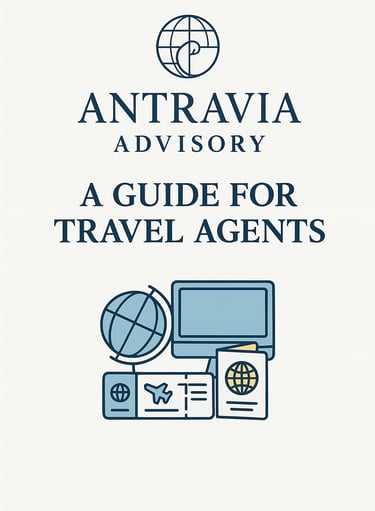
Travel Agent Finance Guide 2025: 4.2 Working Capital and Liquidity Management
Part 4.2 of the Antravia Travel Agent Finance Guide explains how to manage working capital and liquidity. Learn why separating client funds, holding reserves, and using credit responsibly are essential for travel agents building financial resilience.
ANTRAVIA TRAVEL AGENT GUIDE
1/14/20256 min read


Part 4: Building Financial Resilience
In the next part of our Travel Agent Finance Guide, we move beyond day-to-day accounting and look at the bigger picture: how to build a financially resilient travel business. This section will cover how to plan for growth, manage working capital, and prepare for shocks such as supplier failures or sudden drops in demand. We will also address financing options, from credit lines to investor funding, and examine how to use financial reporting to guide long-term decisions. The goal is to give travel agents a framework for sustainability, so you can not only survive but thrive in a constantly shifting industry.
4.1 Forecasting and Planning for Growth
Why forward-looking cash flow forecasts are critical
Using booking patterns, seasonality, and pipeline data to anticipate revenue
Planning for expansion into new markets or niches
Setting aside reserves during strong months to cushion weaker periods
4.2 Working Capital and Liquidity Management
Understanding the timing gap between client deposits and supplier payments
Maintaining liquidity to cover chargebacks, refunds, or delayed commissions
Best practices for separating operating capital from client money
Using short-term reserves and credit responsibly
4.3 Financing Options for Travel Agents
Credit lines and small business loans: what banks actually look for
SBA loans and financing programs in the U.S.
Investor funding: when it makes sense, when it doesn’t
Host agency advances and supplier credit terms as hidden financing sources
Surviving the first years
4.4 Preparing for Industry Shocks
Supplier insolvency: how to protect clients and your own cash flow
Sudden demand drops (pandemics, geopolitical events, recessions)
Insurance strategies: business interruption, professional liability, cyber risk
Building flexibility into your cost base so you can adapt quickly
4.5 Using Financial Reporting for Strategy
How to use profit and loss, balance sheet, and cash flow together
Identifying trends: revenue per booking, cancellation ratios, client lifetime value
Moving from reactive to proactive decision-making
Using financial data to position your agency for long-term sustainability


Part 4.2 Working Capital and Liquidity Management
Working capital is the lifeblood of a travel agency. It is the difference between cash coming in from clients and cash going out to suppliers, staff, and overheads. Liquidity—the ability to turn that working capital into ready funds when needed—is what determines whether an agency can survive shocks or has to scramble for credit. Many travel businesses fail not because they lack sales, but because they mismanage the timing of cash.
Understanding the timing gap
One of the defining features of travel finance is the mismatch between client deposits and supplier payments. A client may pay a $3,000 deposit for a tour in January, yet the balance may not be due to the supplier until April. Meanwhile, your commission might not be released until after the client travels in July.
This can create a false sense of comfort if you are only watching your bank balance. The money may appear available, but in reality much of it belongs to suppliers. Using those funds to cover overheads is one of the fastest ways to dig into a liquidity hole. This is why clear tracking and separation of funds is essential.
Liquidity buffers for real-world risks
Resilient agencies plan for three common liquidity drains:
Chargebacks – A client disputes a payment, and the card processor withholds funds. In peak travel seasons, multiple disputes can lock up thousands of dollars for months.
Refund surges – Geopolitical events, pandemics, or airline collapses can create waves of refund requests. Agents who had no buffer during COVID-19 found themselves refunding more than they had in free cash.
Delayed commissions – Certain cruise lines and tour operators pay 60–90 days after travel, not after booking. That means cash you expected in July might not arrive until September or October.
The practical solution is to hold a liquidity reserve equal to at least one month of fixed costs (rent, salaries, software, insurance). For agents with higher risk exposure, such as selling expensive international trips or using suppliers with long payment lags, two to three months of reserves is safer.
Best practices for separating client money
In some jurisdictions, such as the UK and Australia, trust accounting rules require client funds to be held in separate accounts. In the U.S., the rules are looser, but the principle is still good practice.
Separate bank accounts: Maintain a dedicated account for client deposits. This ensures you never mistake supplier money for working capital.
Reconciliation discipline: Match deposits and supplier liabilities at least weekly. Software such as Xero or QuickBooks can help automate reconciliation, but even a spreadsheet will prevent drift.
Clear reporting: Your financial reports should always show “client funds held” as a liability, not income. This avoids inflating revenue and misrepresenting cash available for operations.
Agencies that ignore this often face crises. A common failure scenario is an agent spending client deposits on marketing, then being unable to pay suppliers when balances fall due. It only takes a few missed supplier payments to lose credibility and collapse client trust.
Responsible use of credit
Credit is not inherently bad, as if it is used well, it can smooth short-term timing issues. But it should never become the main source of liquidity.
Revolving credit lines: A small overdraft or revolving line with a bank can cover short-term mismatches. These usually require financial statements and proof of stable cash flow.
Business credit cards: Useful for temporary cash flow cover, but dangerous if balances are carried long-term. Interest rates of 15–25 percent quickly erode profits.
Supplier credit: Some wholesalers allow settlement after departure or offer commission advances. While this can help, it is risky to build your model on supplier financing that may be withdrawn without warning.
The key is to use credit as a bridge and not as a foundation for your business. If you find yourself routinely relying on credit cards or advances to make payroll, it is a signal your working capital model is broken.
Short-term reserves and liquidity strategy
Beyond separating client funds, create a tiered reserve system:
Operational reserve – A small buffer to cover monthly overhead.
Risk reserve – A larger pool to handle chargebacks, refunds, or supplier collapse.
Growth reserve – Funds set aside for expansion opportunities, so you do not undermine liquidity when investing in marketing or new niches.
For example, a mid-sized agency with $50,000 monthly fixed costs might target $150,000 across the three reserves: $50,000 for operations, $50,000 for risks, and $50,000 for growth. While ambitious, building towards this goal in increments transforms stability.
Practical tools and monitoring
Managing liquidity requires visibility. Some practical steps include:
Weekly cash dashboard: Track inflows (client deposits, commissions), outflows (supplier balances, payroll), and net liquidity.
Rolling 13-week cash flow: This is the gold standard in treasury management, showing weekly cash availability over the next quarter. Many accounting software packages have templates for this.
Alerts for low balances: Set thresholds in your bank accounts or software so you are notified when balances fall below the reserve level.
Scenario testing: Model “what if” cases.. e.g., 20% of clients cancel, a major supplier delays commissions by 90 days, and see if reserves hold.
Example scenario
Consider a hosted agent with $20,000 of deposits collected in March. Supplier balances of $12,000 are due in May, but commissions of $5,000 will only arrive in July. If the agent uses all $20,000 in March to pay overheads, they will face a liquidity crunch in May. With a working capital forecast, the agent could see the May gap in advance, hold back $12,000, and avoid reliance on emergency credit.
Building resilience through liquidity discipline
At its core, working capital management is about honesty with yourself: recognising that not all cash in your account belongs to you, and protecting liquidity against the risks you cannot predict. Agencies that respect this discipline are the ones that can survive downturns and grow sustainably.
Additional blog on Cashflow for Travel Agents - Blog




References for Part 4.2 Working Capital and Liquidity Management
U.S. Small Business Administration (SBA). Manage Your Cash Flow. Available at: https://www.sba.gov/business-guide/manage-your-business/manage-your-cash-flow
Chartered Institute of Management Accountants (CIMA). Working Capital Management. Available at: https://www.cimaglobal.com/Research--Insight/Working-capital-management
Association of Chartered Certified Accountants (ACCA). Technical Factsheet: Cash Flow and Liquidity Management. Available at: https://www.accaglobal.com/an/en/technical-activities/technical-resources-search/2014/january/cash-flow-and-liquidity-management.html
Investopedia. Working Capital Management: Definition, Formula, and Examples. Available at: https://www.investopedia.com/terms/w/workingcapitalmanagement.asp
Organisation for Economic Co-operation and Development (OECD). SME Financing and Liquidity. Available at: https://www.oecd.org/cfe/smes/
HighRadius. What is Working Capital Management? Available at: https://www.highradius.com/resources/Blog/what-is-working-capital-management
Treasury Today. The Importance of Liquidity Management. Available at: https://www.treasurytoday.com/2021/06/the-importance-of-liquidity-management


Acknowledgements
Antravia would like to thank our consulting clients and industry partners who generously shared their time, insights, and real-world case studies. All client examples have been anonymized and edited for clarity, but they are based on true advisory engagements and reflect real decisions, challenges, and financial outcomes from across the travel industry.
Antravia Advisory
Where Travel Meets Smart Finance
Email:
Contact us:
Antravia LLC
© 2025. All rights reserved. | Disclaimer | Privacy Policy | Terms of Use | Accessibility Statement
Antravia.com - Global site of the Antravia Group.
Antravia.com | Antravia.co.uk | Antravia.ae |
Finance.travel | Tax.travel | Consultancy.travel | Vat.travel | Vat.claims |
USSales.tax | EuroVAT.tax | UKVAT.tax |
contact@antravia.com
Antravia LLC
4539 N 22nd St., Ste. N
Phoenix
Arizona
85016
